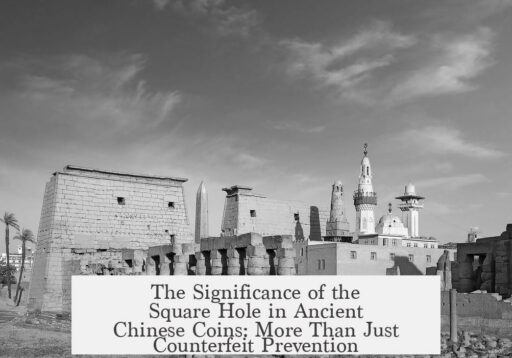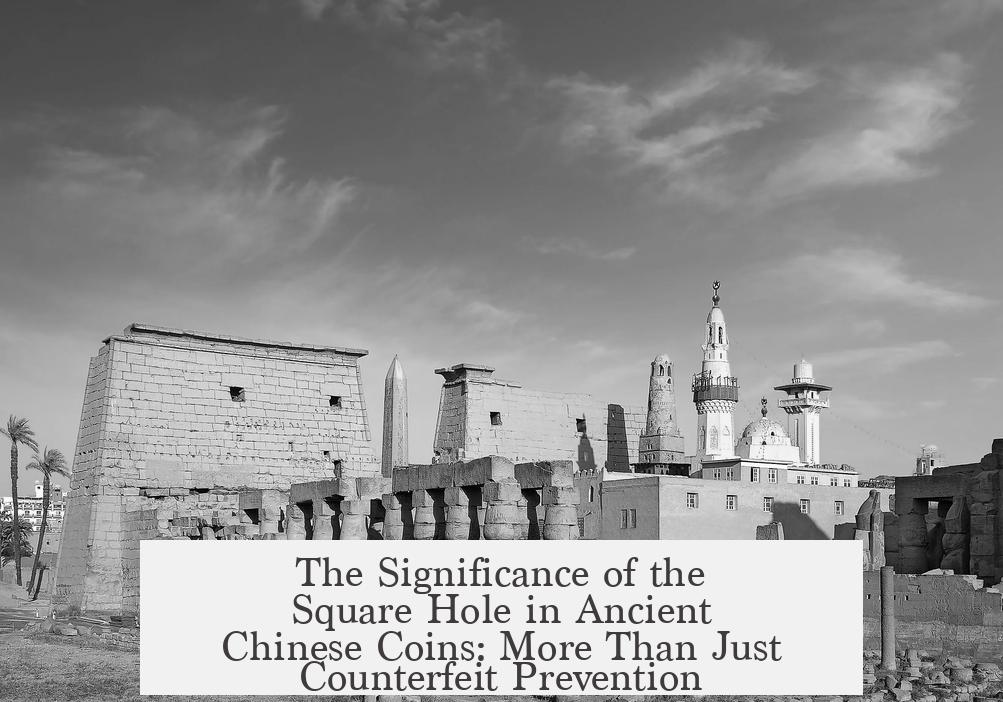Former Chinese coins featured a square hole in the center primarily for functional reasons related to manufacturing and practical use, rather than for security against counterfeiting.
The square hole allowed multiple coins to be mounted on an axle during production. This design enabled the coins to be rotated on a lathe, facilitating the smoothing of rough edges on large batches efficiently. This method improved the uniformity and quality of the coins without requiring individual finishing.
Beyond manufacturing, the square hole played a key role in everyday transactions. Cash coins typically had low individual value, especially during the Qing dynasty. People commonly threaded coins through cords or strings for convenience. Carrying coins as strings made handling large sums easier, avoiding the need to count and manage loose coins individually.
- A standard string, or chuan (串), typically held about 1,000 coins.
- A smaller bundle called a diao (吊), usually contained around 100 coins.
- These strings facilitated trade and commerce in markets and daily life.
This system also reflects the economic context. For example, during the Kangxi Emperor’s reign (1661–1722), typical prices included about 10 coins for a bowl of noodles, 4 coins for a side dish, and 2 coins for a pot of tea. Such low values for single coins made stringing them together practical.
In the late Qing period, China introduced milled coinage to modernize currency. Some of these coins retained the square hole as a traditional design feature, particularly in smaller denominations. However, larger denominations did not have a hole, indicating the hole’s importance primarily for small-value coins used in bulk.
| Aspect | Purpose or Fact |
|---|---|
| Manufacturing | Square holes fitted on axles for smoothing edges via lathe |
| Handling and Storage | Allowed stringing of coins for ease of carrying and counting |
| Economic Usage | Common practice to handle bulk low-value coins as strings |
| Modernization | Some late Qing milled coins kept holes; higher values dropped the feature |
The square hole was a practical solution that aligned with manufacturing technology and economic realities in historical China. It was not designed primarily as anti-counterfeiting, but as a useful functional characteristic.
- Square hole enabled lathe finishing during production.
- Allowed coins to be strung for easy handling and storage.
- Addressed the low value of individual coins by bundling.
- Retained as a traditional feature even in some modernized coinage.
Why Did Former Chinese Coins Have a Squared Hole in the Center? More Than Just a Counterfeit Fix!

Ever stumbled upon an old Chinese coin and wondered why it sports that unmistakable square hole smack dab in the middle? The quick answer: It wasn’t merely a sneaky move to deter counterfeiters. The square hole in traditional Chinese coins actually had multiple practical, economic, and even cultural uses.
Let’s unpack this fascinating aspect of ancient coinage and explore why that hole was far from a random design choice.
The Manufacturing Magic Behind the Square Hole
First impressions might lead you to believe the hole was just to make counterfeiting harder, but the reality is more rooted in production practicality. Ancient East Asian coins were primarily produced by casting, not the striking method popular in Europe and India.
To clarify:
- Striking: Involves taking a metal blank or flan and hammering a die onto it to impress the coin’s design—manually intensive but yields crisp images.
- Casting: Molten metal is poured into molds and left to cool and harden—less laborious overall, but demands clever mold design to maintain quality.
Chinese coins’ square hole fit perfectly into the casting method’s needs. The hole allowed the coins to be easily aligned on an axle fitted into a lathe. Workers could then quickly smooth the rough edges of batches of coins all at once, streamlining production enormously.
Without the hole, these finishing touches would have been much harder and slower. So, the square hole literally kept the machines—and the workforce—humming efficiently.
More Than Manufacturing: Holding Coins Together
The square hole wasn’t just a factory feature; it served a very day-to-day practical function, too. Coins were strung together on cords through this hole—think of it as ancient Chinese coin bracelets or keyrings.
By the Qing period, carrying coins on strings was standard practice. The hole made it easy to bundle thousands together, solve the problem of losing loose coins, and speed up transactions.
Fun fact: A “string” (called 串, chuan) contained about 1,000 coins, while a “hang” (吊, diao) usually held around 100 coins. Imagine having to do math with those in your pocket!
To put values in perspective, during Emperor Kangxi’s reign (1661–1722), you could snag a bowl of noodles for just 10 coins or a pot of tea for 2. Carrying these in strings made daily life simpler—without a coin purse to jingle.
Charms, Symbolism, and Culture

Interestingly, beyond coins and commerce, these stringed coins became charms and symbols of good luck. Though the origins of using these coin strings as charms are murky, Qing-era records show people widely adopted this practice. So, the square hole shaped more than currency—it shaped culture.
The Square Hole on the Edge of Change
By the twilight years of the Qing dynasty, milled coinage—with sharper, more uniform edges—entered the scene. Some of these newer coins held onto the square hole as a nod to tradition, but many higher value coins didn’t include it.
The smallest denominations retained the hole, maintaining that handy string function for the copper pennies. Larger-value coins opted for solid discs, likely reflecting a shift toward modern coinage standards.
Was the Hole Meant to Prevent Counterfeiting?
Now for that popular theory! Did the square hole make coins harder to counterfeit? Not really.
The hole didn’t act as a security feature in the sense of making fraud tougher. Why? Because forged coins could easily replicate the hole. Instead, the design sharpened production efficiency and everyday convenience.
The casting method itself limited counterfeiting possibilities more than the hole. Forgers would struggle to replicate the correct metal composition and design details.
Summing Up: The Honest Truth Behind the Hole

So, why did former Chinese coins have a square hole in their center? It served several smart, practical purposes:
- Manufacturing efficiency: The hole allowed coins to be loaded onto lathes, making edge-finishing smoother and faster.
- Convenient storage and transport: Strings of coins were easier to carry, count, and pay with.
- Cultural and symbolic roles: Coins strung together evolved into charms and lucky talismans.
The hole wasn’t just a design quirk or anti-counterfeit gimmick. It was a clever multi-purpose feature that underpinned everyday economic life in historical China.
Want To Experience This Yourself?
Visit any East Asian history museum, and you’ll spot many coins with square holes. Try threading a few on a string—it’s instantly clear why this was practical long before wallets came along.
So next time you see that square hole, think of the delightful blend of ancient tech, culture, and commerce it represents. Who knew a simple hole could tell such a rich story?



